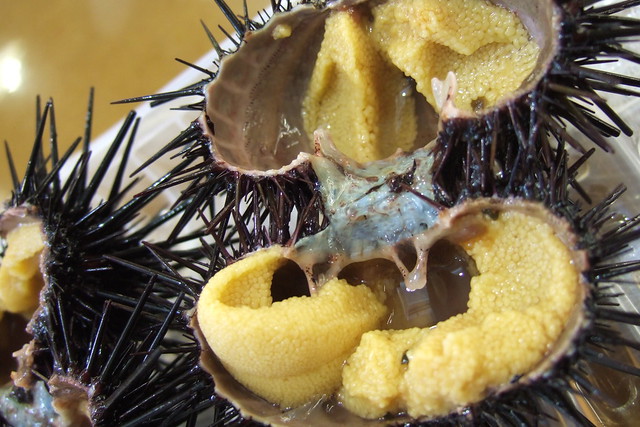Meet John Shea. I met him as I was walking along an aisle at the Fine Food Australia trade fair, absolutely starving. John offered a friendly smile and some fabulous mussels, and then as we got chatting, he offered me some sea urchin. SEA URCHIN. Some of the freshest, plumpest, most delicious sea urchin I've ever had. So of course I had to find out more.

Photo by Tokyo Foodcast
From my chat with John, I learnt that the Sea Urchin has five tongues, which are hold the
And as with any living produce, there is most definitely a season to sea urchin. According to John, there is a saying in New Zealand, which is that the sea urchin is 'ripe' when the pohutukawa (a plant) is in bloom. This means that the sea urchin harvesting season corresponds to summer, which is when this particular plant is in bloom.
So what is a 'ripe' sea urchin? And why harvest in summer?
Well, it turns out that when the water is cold (during winter), it's not a good time to spawn. And since we're basically eating the reproductive organs of the sea urchin, that means that not a good time for spawning = no roe. But in the lead up to the warmer months, the sea urchin start gearing up for reproduction, meaning that the tongues start getting plump and firm, and swelling up, ready to 'give birth'. This is the best time to harvest and eat sea urchin, because you end up with an amazing, fresh, plump product.
If you harvest them too late, then well...we all know that birthing can be a traumatic event.
The colour of the sea urchin also varies. Some are a light yellow, and varies right into a dark brown. All of that just really has to do with the fact that mother nature doesn't quite make everything consistent, and the dark brown sea urchin, while not as pretty in presentation, is still just as yummy. Trust me, I've tried.
If you want to go out and get some of this deliciousness for yourself, then be sure to pick urchin that is plump and firm - not watery - and smells like the sea. If it smells fishy, then it's no good - sea urchin has a pretty short shelf life. Even better when you can see the little roe - it should look rough like the surface of your tongue. If you were eating it straight, I would definitely suggest that you can get them plump if you can - it's so worthwhile for the texture and flavour that they provide.
The urchin that I've tried from Cando fishing is MASSIVE by the standards that I've seen in most reputable Japanese restaurants. I've never had urchin as satisfying and decadent, and I'm not saying this because John was lovely enough to give me product to sample. They are really quite versatile, and delicious, and it's inspired me to come up with a few recipes with sea urchin.
How do you like to enjoy your sea urchin?

Very interesting facts, and I just realised I've only had sea urchin once or twice... gotta do something about that!
ReplyDelete